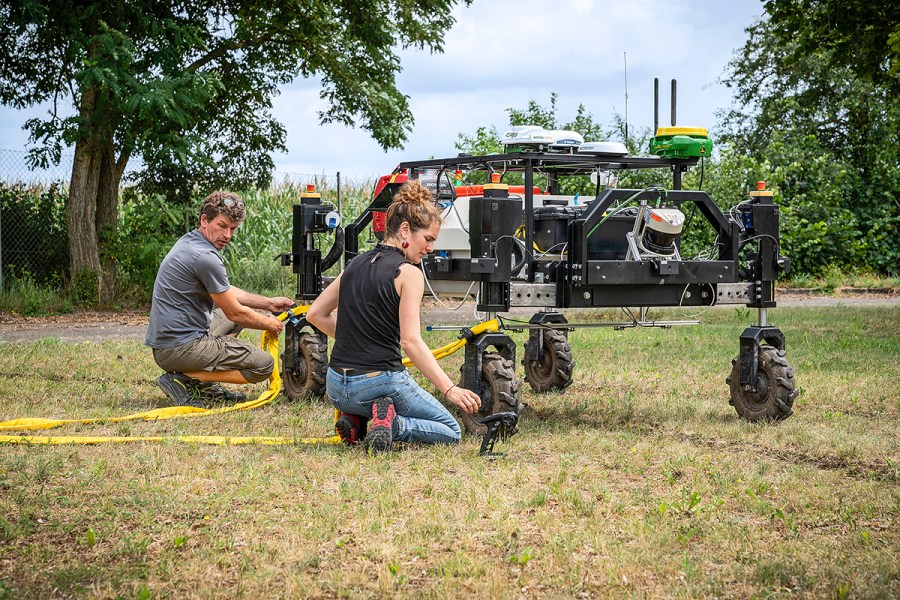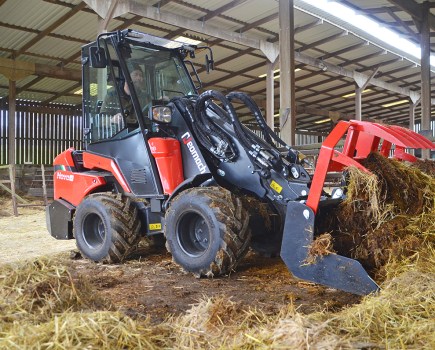There can be a big difference in price between high-end and low-cost RTK GNSS receivers. We wanted to find out whether spending extra means better accuracy.
KEEPING IT BRIEF
- There is a large variation in prices for different makes.
- The differences in accuracy and reliability are marginal.
- You can buy GNSS chipsets online for a few hundred pounds, if you plan on building your own system with the likes of AgOpen GPS.
- If mobile phone reception is poor in your area, you should pay attention to the RTK bridging times.
- GNSS stands for Global Navigation Satellite System.
Without a GNSS receiver, auto-steering on tractors or section control on sprayers wouldn’t work. Its critical role clearly makes the GNSS receiver the centrepiece for precision farming and exact match-ups when turning back into work. With RTK correction, satellite-positioning accuracy can be further improved down to just a few centimetres. Manufacturers usually quote a pass-to-pass accuracy of +/-2.0 to 2.5cm for RTK GNSS receivers.
Thats’s a very theoretical figure. In practice, other influencing factors play their part — such as how effectively the IMU (Inertial Measurement Unit), with its integrated 3D sensors, is able to compensate for a tractor’s pitch and roll, and also how precisely the hydraulics or electric motor translate the steering commands into movement. Just as important, the RTK correction signal needs to be available without interruption — a potential problem if the signal is coming from the mobile network and reception is patchy.
Wide price range
There’s a wide range of GNSS receivers on the market. In our test, they started at just €200 (about £170) for a ‘bare’ set of chips plus the antenna. Looking a little more familiar to most are the receivers already housed in a plastic dome, configured by the manufacturer for their specific applications; these cost between around £1,900 and £5,600.
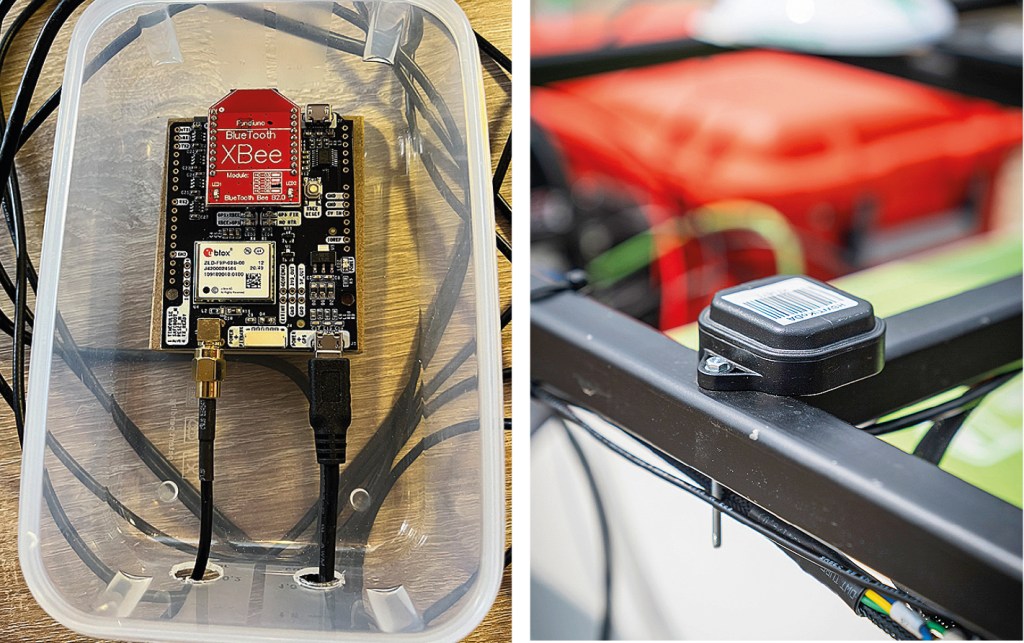
It’s also worth pointing out that the GNSS receiver is commonly part of a complete steering system. You can’t simply just swap it for one from a different manufacturer, even though the NMEA 0183 data output standard applies. For instance, you can’t just connect a low-cost U-blox receiver to a John Deere steering system.
Despite this constraint, we still wanted to know: what does an expensive receiver offer that a budget unit doesn’t? After all, the GNSS receiver unit is at the very heart of any well-functioning steering system. Any differences in antennas, cabling and the electronics used could all ultimately affect accuracy.
Signal processing is also absolutely crucial for determining an accurate position, which is particularly important when the unit is on the move, as the receiver also calculates the direction of travel and speed from the satellite signals.
So, together with the Weihenstephan-Triesdorf University (HSWT), a total of seven receivers came under scrutiny, testing their accuracy and reliability on the move — and also how they coped when the signal was obscured.
It is worth pointing out that not all of these receivers are readily available in the UK.
These were the test candidates:
- Agra-GPS CRG (Granary Precision Services)
- ArduSimple simpleRTK2B
- John Deere StarFire 7500
- Raven RS1
- Reichhardt RGS700
- Satcon System All-in-One 4G (Cleveland Alliances)
- Trimble NAV-900

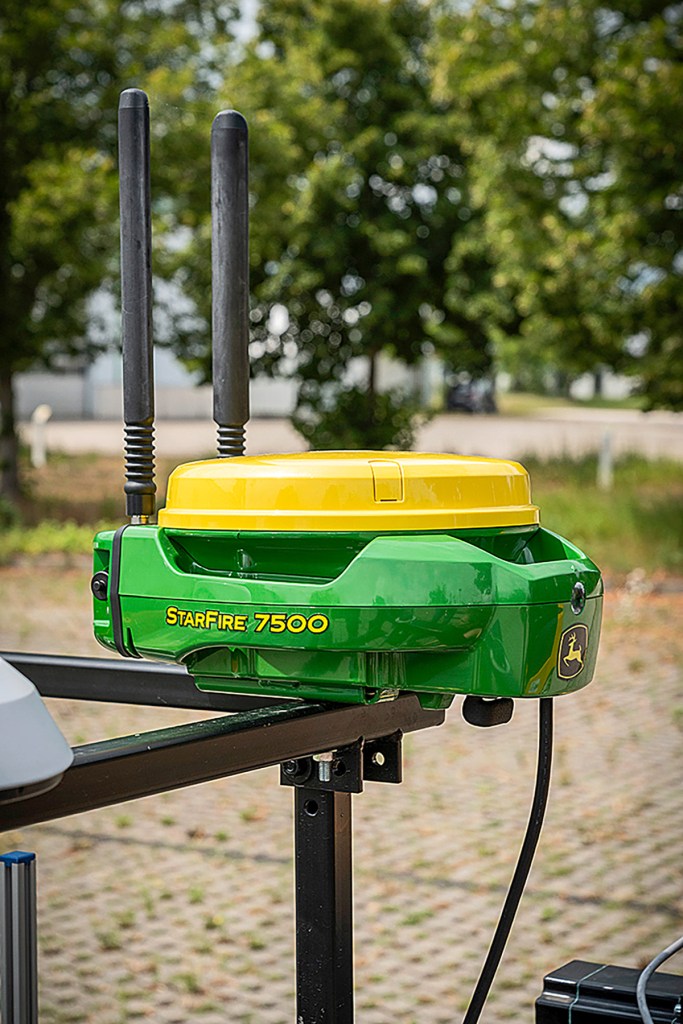
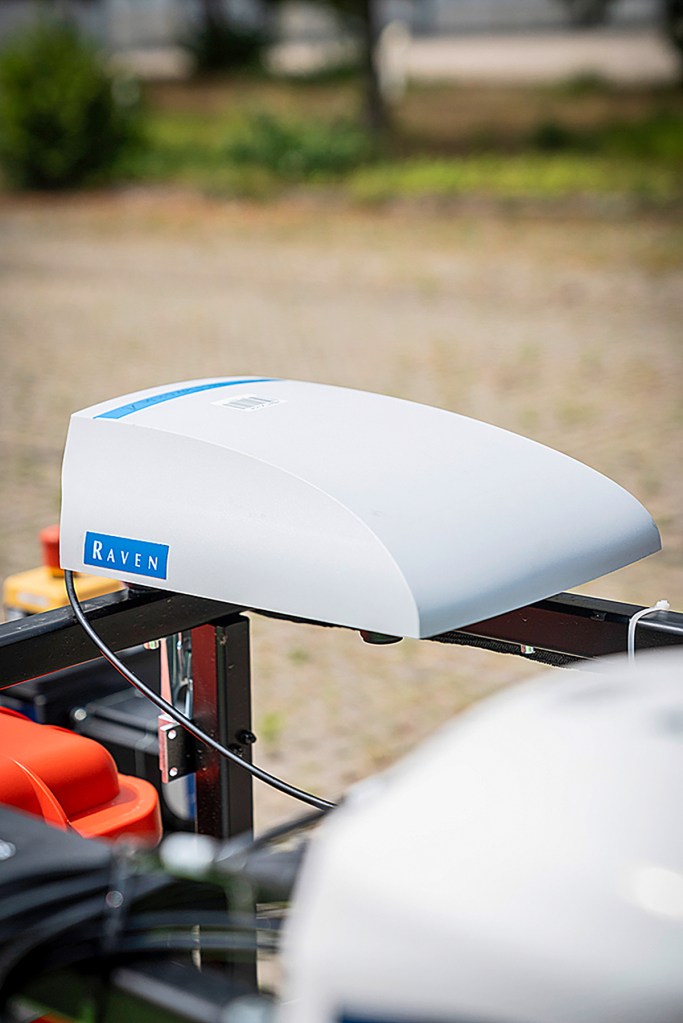

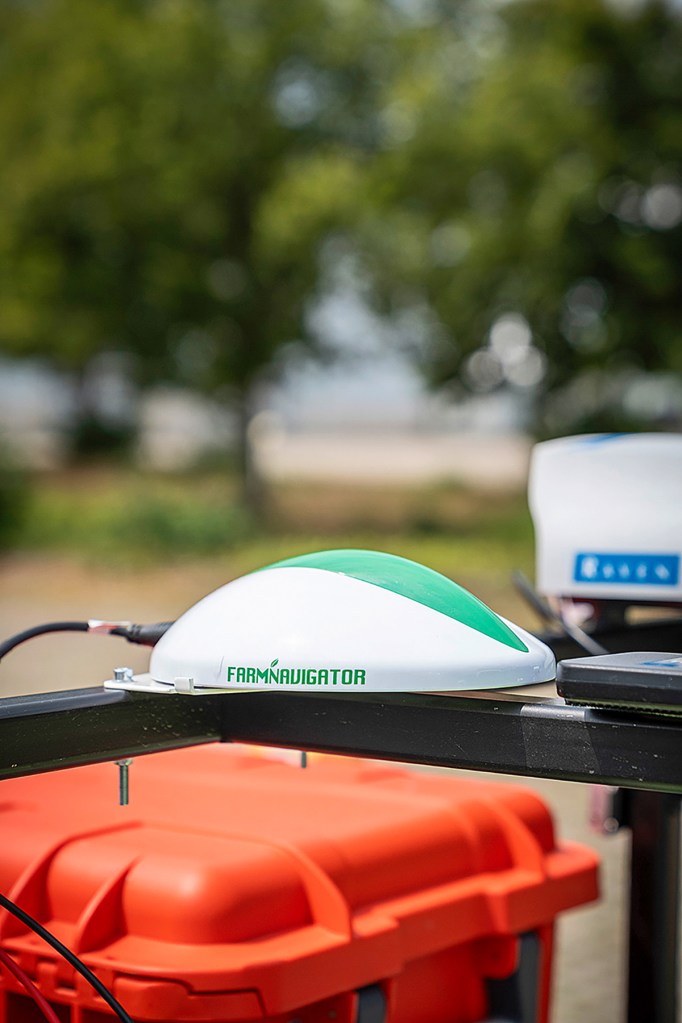
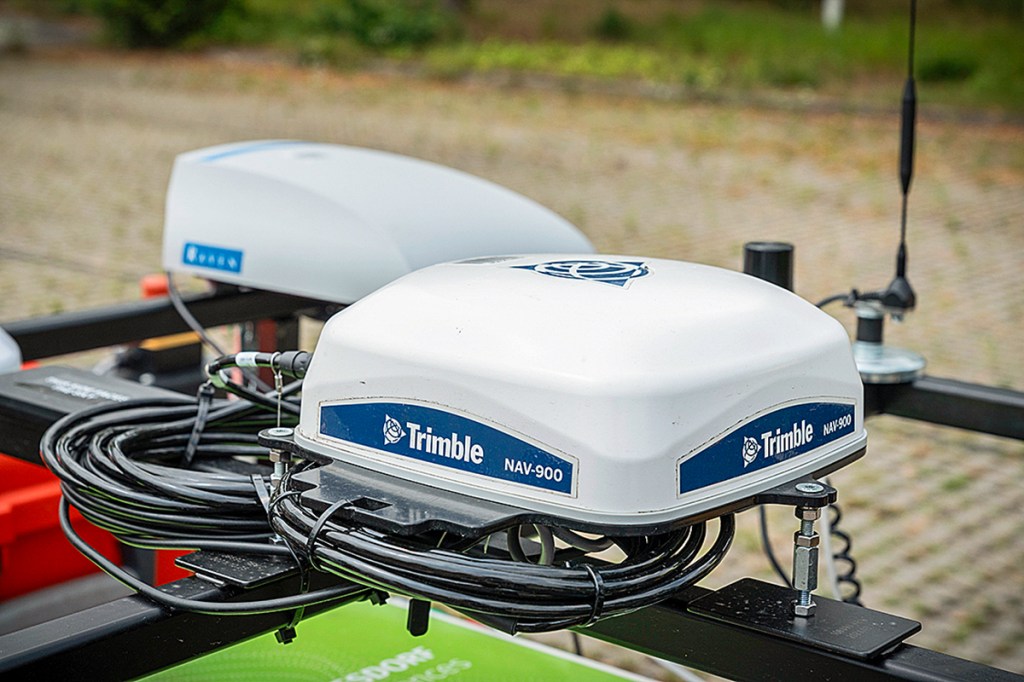
Data in comparison
We’ve compiled some of the technical specs and receiver prices in the spec table ‘GNSS receivers compared’. While some of the technical specs may only be of interest to those with a penchant for the finer data details, it’s still worth noting that Agra-GPS and Satcon System use the same chipset as the U-blox board that we bought online from ArduSimple.
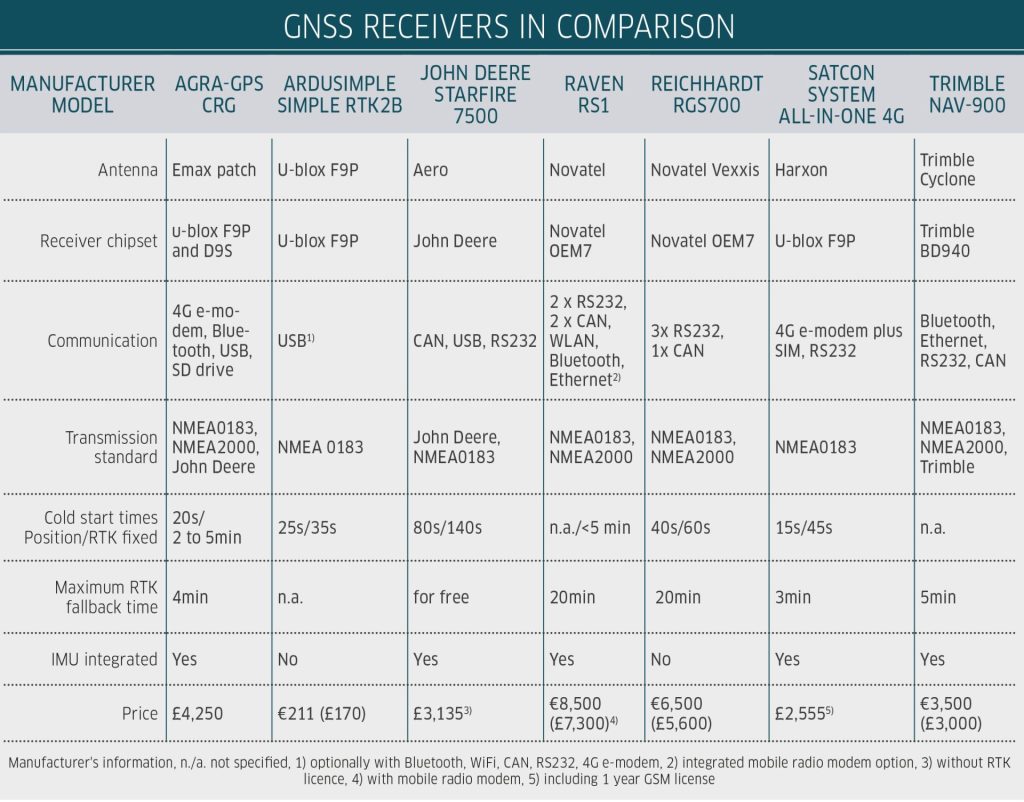
And here’s what’s not shown in the table: all GNSS receivers can process GPS, GLONASS, Galileo and BeiDou signals and correct them using RTK data. John Deere, Reichhardt and Trimble all operate their own RTK correction networks for their position correction: John Deere offers SF-RTK, a satellite-based RTK-like correction service (licence costs start at £475 for twelve months). The advantage of this system is that no extra hardware or activation is needed to receive a mobile RTK signal; it only takes the GNSS receiver. The Agra-GPS receiver unit with the U-blox D9S chip can also receive an RTK-like signal via satellite.
RTK modem
The mobile modem that’s needed for RTK reception via Ntrip from the internet is already built into Agra-GPS’s CRG and the Satcon All-in-One 4G receiver units. These modems work with a virtual SIM card.
The U-blox receiver can also be ordered with an integrated modem — ArduSimple sells it for €449. The receivers from John Deere, Raven, Reichhardt and Trimble need either an integrated modem or an external connection. The cost of this option ranges between €1,600 and €2,085. There are also additional costs involving the SIM card and activating mobile data.
Also note: the John Deere StarFire 7500 requires an unlimited mobile RTK licence, which costs an extra £4,135.
For our test all of the receivers used the German Sapos RTK network to correct their GNSS positioning data. This ensured the same conditions for all seven units. You’ll find the details of how we tested accuracy in straight-line and curved-line operation, and signal behaviour under shadows in the box titled ‘How we tested’ on the next page.
The measurements are also shown in the charts on the following pages. The box plots show the range of measured values, with each box covering 50% of the measurements. We also marked the mean variation as a dot.

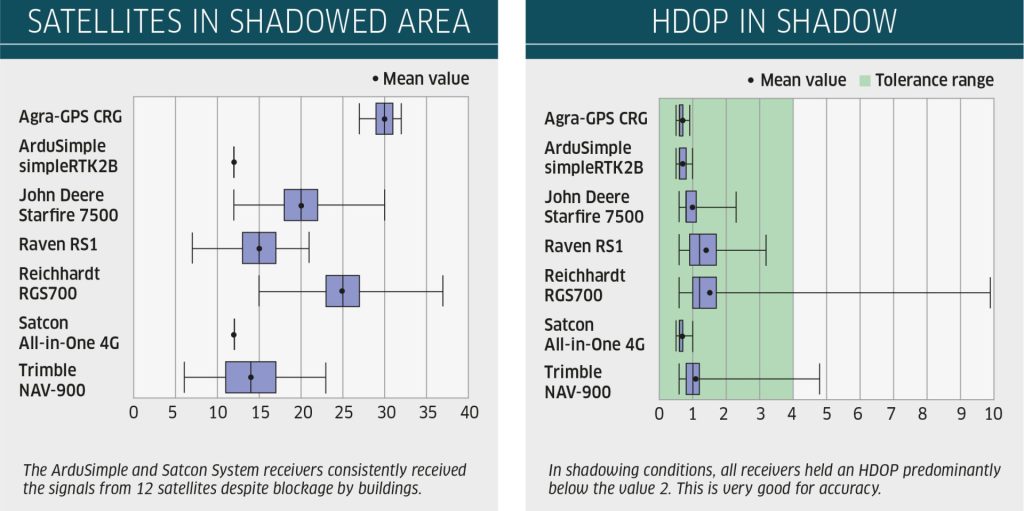
Precise tracking
The straight-line tracking data show that all seven GNSS receivers with the Sapos RTK correction mostly delivered the accuracy promised by the manufacturers. In nearly all of the once-per-second readings taken from a total of 42 test runs, the deviation was less than 2cm (see the ‘Straight-line travel’ chart). Forward speed had no impact on this.
To assess the pass-to-pass accuracy of the Reichhardt RGS700, we had to rely on the RMC position data in the NMEA messages — which is not usually the case. GNSS receiver units typically use GGA data for positioning; however, the Reichhardt receiver unit only outputted this data with only four decimal places in our test. At worst, this could result in position errors of around 20cm. It turned out that Reichhardt hadn’t configured the receiver correctly. It should have outputted GGA data with eight decimal places.
In the real world, this incorrect configuration would have repercussions because external section control systems rely on the position data within the GGA message transmitted by the serial cable. Because Reichhardt’s proprietary steering system uses RMC data, a GGA output issue would go unnoticed.
Curves without complaint
In the curved-line guidance tests, deviations were slightly more scattered than in the straight-line test runs. However, this didn’t significantly affect system accuracy. Half the readings from the 54 circular runs ranged between -1.8 and +1.1 cm — all well within tolerance. There were no major differences between the individual receivers. Yet we spotted that positioning accuracy declined when ground speed increased. This was likely down to the rather jerky movements of the carrier vehicle that was following the circular test course.
Stable position
The third test focused on the positioning reliability when trees, for example, block the signal, or, as in our test scenario, when the vehicle is moving between buildings or under a bridge. One key thing to point out straightaway: signal shielding affected all seven receivers, and there weren’t any big differences between them — all maintained good position accuracy.
We relied on the number of satellites being received, the HDOP value and RTK status as being the test parameters. We also looked at the ground speed and heading signals as computed by the GNSS receivers. Accurate speed measurement is critical for jobs using section control.
All of the receivers recorded similar speeds, averaging 4km/hr during the 30 test runs under the bridge. Only a few variations were scattered around this average value.
The same applied for the heading values. Except for one, all the receivers delivered fairly consistent and reliable readings. The Satcon receiver produced a number of major deviations from the actual direction, which was presumably down to incorrect pre-sets. This assumption is supported by the fact that the vehicle significantly went off course even in terrain where signals were not blocked. This surprised us because the Satcon All-in-One 4G has the same receiver chipset as the ArduSimple, which was also part of the assembled test group and it maintained the correct setting.
HDOP is the standard metric for indicating the quality of the satellite geometry. The smaller the value, the better. HDOP values below 2 are rated as good to very good. Slightly higher values of up to 4 generally don’t have much impact on auto-steering or section control accuracy. The graph above (HDOP in shadow) shows that 75% of the HDOP values of all test candidates was less than 2. For receivers with the F9P chipset (Agra-GPS, ArduSimple, Satcon), the HDOP never rose above 1 — which is excellent. Albeit the Reichhardt RGS700 unit showed the widest spread, 97% stayed below the critical HDOP threshold of 4.
As GNSS receivers calculate position using signal trilateration, one might assume that more satellites mean higher accuracy. But that’s not always the case. Errors can occur if the receiver uses signals from satellites low on the horizon. It’s interesting that both the Satcon System All-in-One 4G and the ArduSimple U-blox receiver kept receiving signals from 12 satellites while driving in a shadowed area. These manufacturers chose to rely only on signals from the best-sited satellites whereas the others used as many satellites as possible. Moreover, for these receivers the number of satellites received changed in the areas where reception was obstructed (see the ‘Satellite reception in blocked area’ chart).
RTK is rarely lost
GNSS receivers can achieve centimetre accuracy only in RTK fix mode. When in RTK float mode, the correction is still applied, though the absolute accuracy drops to the decimetre range, as phase correction is missing, which is key for high accuracy.
In DGPS mode, the receiver doesn’t use RTK but a satellite-based correction like EGNOS or John Deere’s free SF1. This third-tier mode offers lower pass-to-pass accuracy, because it only corrects the GNSS signal timing.
That’s why it was important to see if — and how long — the receivers held their RTK fix status during signal shadowing. Depending on how long RTK is lost — and depending on the application — the loss of the RTK fix status could affect the quality of work and even lead to halting the machine (similar to autonomous field robots).

During our test runs, some receivers briefly lost their RTK fix status due to shadowing. Agra-GPS and Satcon spent around 10% of the time in RTK float mode, while the John Deere StarFire 7500 dropped into DGPS mode.
The Reichhardt RGS700 and Raven RS1 maintained the RTK fix status throughout the entire test, albeit the Raven receiver occasionally failed outputting data, a trait that we couldn’t explain.
Summary
In our tests, the seven GNSS receivers showed no significant differences with regard to average positioning accuracy or reliability — both in straight and curved lines. Even in deliberately created blockage scenarios, all the test units continued with acceptable accuracy.
This means that even a low-budget GNSS receiver can perform well. What’s more, a good receiver can’t make up for a poorly configured steering system, because the GNSS receiver is at the heart of any system accuracy. What’s also essential is that all components must work together properly … in hassle-free harmony.
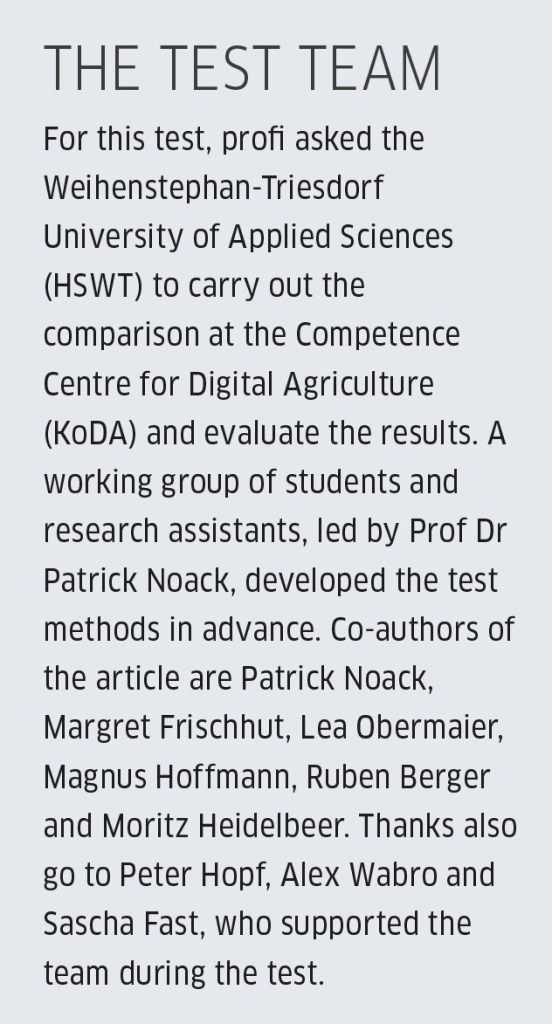

Anja Böhrnsen
For more up-to-date farming news click here and subscribe now to profi and save.

